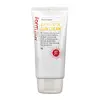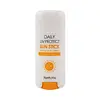What's inside
What's inside
 Key Ingredients
Key Ingredients

 Benefits
Benefits

 Concerns
Concerns

 Ingredients Side-by-side
Ingredients Side-by-side

Water
Skin ConditioningParaffinum Liquidum
EmollientEthylhexyl Methoxycinnamate
UV AbsorberCetearyl Alcohol
EmollientStearic Acid
CleansingGlyceryl Stearate
EmollientPEG-100 Stearate
Polysorbate 60
EmulsifyingTitanium Dioxide
Cosmetic ColorantBeeswax
Emulsion StabilisingGlyceryl Stearate Se
EmulsifyingDimethicone
EmollientTocopheryl Acetate
AntioxidantAscorbyl Palmitate
AntioxidantTriethanolamine
BufferingCarbomer
Emulsion StabilisingParfum
MaskingMethylparaben
PreservativePropylparaben
PreservativeDisodium EDTA
Water, Paraffinum Liquidum, Ethylhexyl Methoxycinnamate, Cetearyl Alcohol, Stearic Acid, Glyceryl Stearate, PEG-100 Stearate, Polysorbate 60, Titanium Dioxide, Beeswax, Glyceryl Stearate Se, Dimethicone, Tocopheryl Acetate, Ascorbyl Palmitate, Triethanolamine, Carbomer, Parfum, Methylparaben, Propylparaben, Disodium EDTA
Polymethyl Methacrylate
Caprylic/Capric Triglyceride
MaskingSilica
AbrasiveOctocrylene
UV AbsorberHomosalate
Skin ConditioningButylene Glycol Dicaprylate/Dicaprate
EmollientDimethicone
EmollientEthylhexyl Salicylate
UV AbsorberParaffin
PerfumingPolyethylene
AbrasiveButyl Methoxydibenzoylmethane
UV AbsorberMicrocrystalline Wax
Emulsion StabilisingBis-Ethylhexyloxyphenol Methoxyphenyl Triazine
Skin ConditioningVinyl Dimethicone/Methicone Silsesquioxane Crosspolymer
Euphorbia Cerifera Wax
Silica Dimethyl Silylate
EmollientAdenosine
Skin ConditioningGlycerin
HumectantDipropylene Glycol
HumectantGlycyrrhiza Glabra Root Extract
BleachingWater
Skin ConditioningHydrogenated Lecithin
EmulsifyingPolyglyceryl-10 Oleate
Skin ConditioningMethicone
EmollientParfum
MaskingPolymethyl Methacrylate, Caprylic/Capric Triglyceride, Silica, Octocrylene, Homosalate, Butylene Glycol Dicaprylate/Dicaprate, Dimethicone, Ethylhexyl Salicylate, Paraffin, Polyethylene, Butyl Methoxydibenzoylmethane, Microcrystalline Wax, Bis-Ethylhexyloxyphenol Methoxyphenyl Triazine, Vinyl Dimethicone/Methicone Silsesquioxane Crosspolymer, Euphorbia Cerifera Wax, Silica Dimethyl Silylate, Adenosine, Glycerin, Dipropylene Glycol, Glycyrrhiza Glabra Root Extract, Water, Hydrogenated Lecithin, Polyglyceryl-10 Oleate, Methicone, Parfum
Ingredients Explained
These ingredients are found in both products.
Ingredients higher up in an ingredient list are typically present in a larger amount.
Dimethicone is a type of synthetic silicone created from natural materials such as quartz.
What it does:
Dimethicone comes in different viscosities:
Depending on the viscosity, dimethicone has different properties.
Ingredients lists don't always show which type is used, so we recommend reaching out to the brand if you have questions about the viscosity.
This ingredient is unlikely to cause irritation because it does not get absorbed into skin. However, people with silicone allergies should be careful about using this ingredient.
Note: Dimethicone may contribute to pilling. This is because it is not oil or water soluble, so pilling may occur when layered with products. When mixed with heavy oils in a formula, the outcome is also quite greasy.
Learn more about DimethiconeParfum is a catch-all term for an ingredient or more that is used to give a scent to products.
Also called "fragrance", this ingredient can be a blend of hundreds of chemicals or plant oils. This means every product with "fragrance" or "parfum" in the ingredients list is a different mixture.
For instance, Habanolide is a proprietary trade name for a specific aroma chemical. When used as a fragrance ingredient in cosmetics, most aroma chemicals fall under the broad labeling category of “FRAGRANCE” or “PARFUM” according to EU and US regulations.
The term 'parfum' or 'fragrance' is not regulated in many countries. In many cases, it is up to the brand to define this term.
For instance, many brands choose to label themselves as "fragrance-free" because they are not using synthetic fragrances. However, their products may still contain ingredients such as essential oils that are considered a fragrance by INCI standards.
One example is Calendula flower extract. Calendula is an essential oil that still imparts a scent or 'fragrance'.
Depending on the blend, the ingredients in the mixture can cause allergies and sensitivities on the skin. Some ingredients that are known EU allergens include linalool and citronellol.
Parfum can also be used to mask or cover an unpleasant scent.
The bottom line is: not all fragrances/parfum/ingredients are created equally. If you are worried about fragrances, we recommend taking a closer look at an ingredient. And of course, we always recommend speaking with a professional.
Learn more about ParfumWater. It's the most common cosmetic ingredient of all. You'll usually see it at the top of ingredient lists, meaning that it makes up the largest part of the product.
So why is it so popular? Water most often acts as a solvent - this means that it helps dissolve other ingredients into the formulation.
You'll also recognize water as that liquid we all need to stay alive. If you see this, drink a glass of water. Stay hydrated!
Learn more about Water